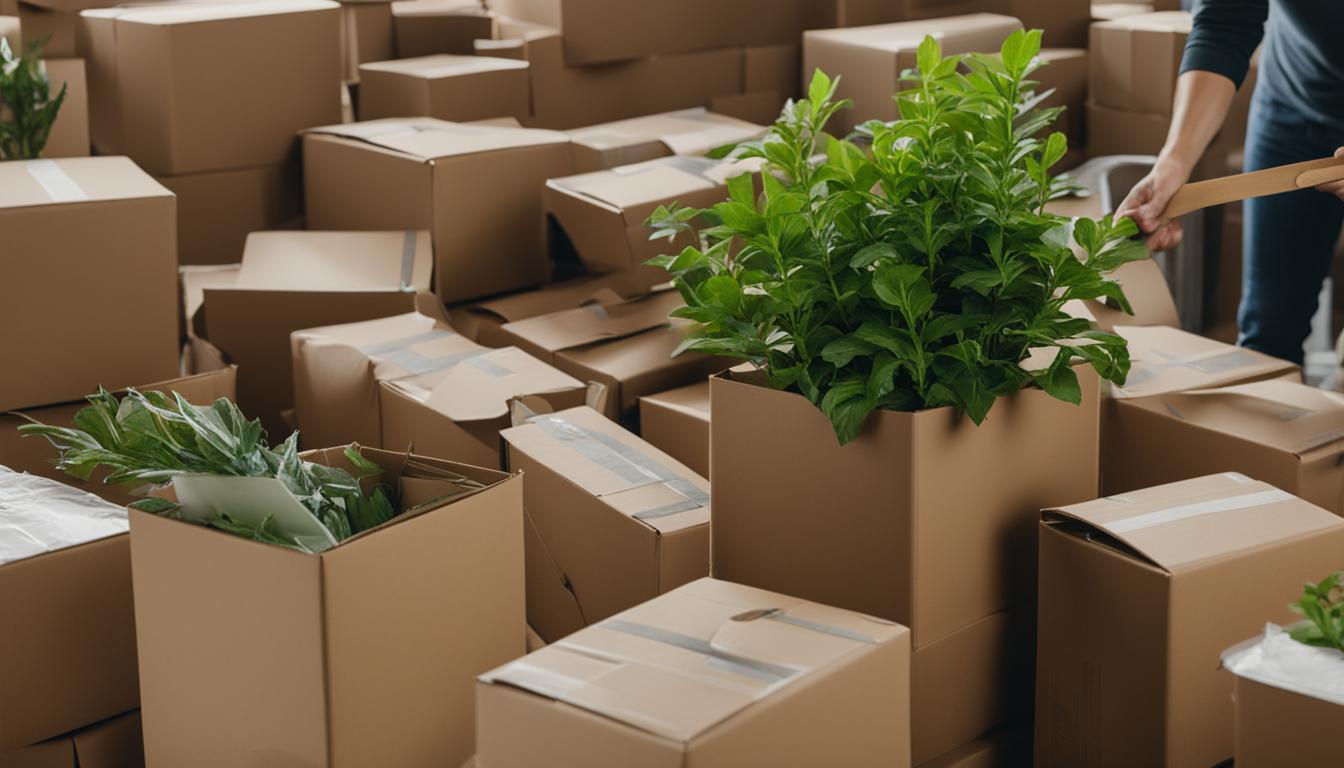The global sustainability movement is reshaping the business landscape, with consumers expressing significant concern about the environmental impact of product packaging. To meet customer expectations and contribute to a greener future, businesses should prioritize sustainable packaging practices. This comprehensive guide will help businesses understand the importance of sustainable packaging and choose suitable options.
Key Takeaways:
- Sustainable packaging is essential for businesses to reduce their carbon footprint and address eco-consciousness.
- Eco-friendly materials and production practices are key aspects of sustainable packaging.
- Benefits of sustainable packaging include improved brand image, waste reduction, and cost savings.
- Businesses can choose from a variety of sustainable packaging materials such as biodegradable, recycled, and compostable materials.
- Implementing sustainable packaging strategies involves integrating sustainability into the business strategy and optimizing the supply chain.
What is Sustainable Packaging?
Sustainable packaging refers to the use of eco-friendly materials and production practices throughout the packaging lifecycle. It involves making conscious choices to minimize the environmental impact of packaging, thereby promoting sustainability and reducing the carbon footprint.
In sustainable packaging, the focus is on selecting renewable, recyclable, and compostable materials. This includes opting for biodegradable materials like bioplastics, which offer a sustainable alternative to conventional plastics. By using recycled and recyclable materials, businesses can minimize waste and contribute to resource conservation. Furthermore, reducing reliance on fossil fuels and adopting energy-efficient production practices are essential components of sustainable packaging.
By adopting sustainable packaging practices, businesses can play a crucial role in protecting the environment and meeting the growing demand for eco-friendly solutions. Embracing sustainable packaging not only benefits the planet but also enhances brand image and reputation. Customers are increasingly drawn to environmentally conscious companies, making sustainable packaging a win-win strategy for businesses and the environment.
Benefits of Sustainable Packaging
Sustainable packaging offers a multitude of benefits, both environmental and social. By reducing carbon emissions and their overall carbon footprint, businesses can actively contribute to combating climate change. This not only helps protect the planet but also showcases a commitment to environmental stewardship, improving brand image and attracting eco-conscious customers.
Waste reduction is another significant benefit of sustainable packaging. By using recyclable materials and minimizing the amount of packaging, businesses can minimize waste sent to landfills and promote a circular economy. Sustainable packaging also enables efficient resource utilization, ensuring that valuable resources are not wasted and can be reused or recycled.
Moreover, sustainable packaging practices help businesses comply with regulatory requirements related to packaging materials and waste management. By prioritizing sustainability, businesses can also achieve cost savings in the long run, such as reduced packaging material costs and improved operational efficiency.
In conclusion, sustainable packaging is a crucial aspect of modern businesses. By adopting eco-friendly materials and production practices, businesses can reduce their environmental impact, enhance their brand image, and gain a competitive advantage in the marketplace.
Benefits of Sustainable Packaging
Adopting sustainable packaging brings numerous environmental and social benefits. By reducing carbon emissions, businesses can minimize their carbon footprint and contribute to the fight against climate change. This not only helps preserve the environment but also demonstrates a commitment to sustainable practices, enhancing brand image and reputation.
Sustainable packaging also plays a crucial role in waste reduction. By prioritizing recyclable and compostable materials, businesses can minimize the amount of packaging waste that ends up in landfills. This not only conserves resources but also reduces the environmental impact associated with waste disposal.
Furthermore, embracing sustainable packaging practices can have a positive social impact. Consumers are increasingly drawn to brands that align with their values, including environmental responsibility. By adopting sustainable packaging, businesses can attract environmentally conscious customers and increase brand loyalty.
“Sustainable packaging not only reduces environmental impact but also enhances brand image and attracts environmentally conscious customers.”
In addition to the environmental and social benefits, sustainable packaging can also have financial advantages for businesses. By optimizing packaging materials and reducing waste, companies can save on costs associated with production, transportation, and waste disposal. Moreover, sustainable packaging practices, such as using recycled materials, can help businesses meet regulatory compliance requirements and avoid potential fines.
Table: Environmental and Economic Benefits of Sustainable Packaging
| Benefit | Description |
|---|---|
| Carbon Footprint Reduction | By minimizing carbon emissions, businesses contribute to the fight against climate change |
| Brand Image Enhancement | Sustainable packaging practices enhance brand reputation and attract environmentally conscious customers |
| Waste Reduction | Prioritizing recyclable and compostable materials reduces the amount of packaging waste sent to landfills |
| Resource Conservation | Using sustainable packaging materials conserves natural resources and reduces reliance on non-renewable materials |
| Social Impact | Embracing sustainable practices aligns with consumer values, leading to increased brand loyalty |
| Regulatory Compliance | Sustainable packaging helps businesses meet environmental regulations and avoid potential fines |
| Cost Savings | Optimizing packaging materials and reducing waste can result in financial savings for businesses |
| Operational Efficiency | Sustainable packaging practices streamline operations and improve overall efficiency |
Types of Sustainable Packaging Materials
When it comes to sustainable packaging, businesses have a variety of options to choose from. By selecting the right materials, companies can reduce their environmental footprint and contribute to a greener future. Here are some of the most common types of sustainable packaging materials:
Biodegradable Materials
Biodegradable materials are designed to break down naturally over time, reducing waste and minimizing environmental impact. These materials can include bioplastics, which are made from renewable resources such as corn or sugarcane. Bioplastics offer a sustainable alternative to conventional plastics, as they are compostable and do not contribute to plastic pollution.
Recycled Materials
Using recycled materials is another effective way to promote sustainability in packaging. Materials such as paper, cardboard, glass, metal, and plastic can be recycled and repurposed, reducing the need for new resource extraction. By incorporating recycled materials into packaging, businesses can help minimize waste and conserve valuable resources.
Compostable Materials
Compostable materials are those that can be broken down through natural processes into nutrient-rich compost. These materials, including certain types of paper and bio-based plastics, provide a sustainable packaging solution that supports circular economy principles. Compostable materials can be returned to the earth as organic matter, enriching the soil and reducing landfill waste.
Plant-Based Materials
Plant-based materials, also known as bio-based materials, are derived from renewable resources such as plants or agricultural by-products. These materials offer a sustainable alternative to petroleum-based plastics and other non-renewable materials. Plant-based packaging can be biodegradable or compostable, depending on the specific material and manufacturing process.
By choosing biodegradable materials, recycled materials, compostable materials, and plant-based materials, businesses can make significant strides towards achieving sustainable packaging practices. These options not only help reduce environmental impact but also demonstrate a commitment to eco-consciousness and meet the growing demand for sustainable alternatives in the market.

Sustainable Packaging Strategies
Integrating sustainability into business strategies is crucial for companies looking to make a positive impact on the environment while also achieving long-term success. By adopting sustainable packaging practices, businesses can contribute to a greener future and differentiate themselves in a competitive marketplace.
One key aspect of sustainable packaging is optimizing the supply chain for sustainability. This involves evaluating and selecting suppliers who offer eco-friendly materials and production practices. By partnering with suppliers committed to sustainability, businesses can ensure that their packaging materials are made from renewable resources and have minimal environmental impact.
Another important strategy is to embrace renewable energy sources in the manufacturing process. By transitioning to renewable energy, such as solar or wind power, businesses can reduce their carbon footprint and decrease dependency on fossil fuels. This not only benefits the environment but also sends a positive message to consumers who value eco-conscious businesses.
Supply Chain Optimization
Efficient manufacturing processes are also essential for sustainable packaging. By adopting advanced technologies and lean practices, businesses can minimize waste, reduce energy consumption, and optimize resource utilization. This not only reduces environmental impact but also improves operational efficiency and lowers costs.
In addition to eco-friendly materials and efficient manufacturing, businesses should prioritize the use of safe chemical ingredients. By avoiding toxic or harmful substances, companies can ensure the safety of their packaging for both consumers and the environment. This includes considering the end-of-life disposal of packaging materials, such as designing for material recovery or biological recovery in a circular economy.
Overall, sustainable packaging strategies encompass various elements, including supply chain optimization, renewable energy sources, efficient manufacturing practices, and safe chemical ingredients. By integrating these strategies into their business operations, companies can play a significant role in reducing environmental impact and shaping a greener future.
| Sustainable Packaging Strategies | Benefits | ||
|---|---|---|---|
| Optimizing the supply chain | – Eco-friendly materials | – Minimal environmental impact | |
| Embracing renewable energy sources | – Reduced carbon footprint | – Decreased dependency on fossil fuels | |
| Efficient manufacturing processes | – Minimized waste | – Improved resource utilization | – Enhanced operational efficiency |
| Using safe chemical ingredients | – Packaging safety for consumers | – Environmental protection |
By integrating sustainable packaging strategies into their business operations, companies can play a significant role in reducing environmental impact and shaping a greener future.
Conclusion
Sustainable packaging has transitioned from a niche concept to a vital element for achieving business success. In a world where environmental impact is increasingly scrutinized, businesses that prioritize sustainability can significantly reduce their carbon footprint and contribute to a greener future.
Embracing sustainable packaging offers more than just environmental benefits. It also provides a competitive advantage in the marketplace. By aligning with the values of eco-conscious consumers, businesses can attract a loyal customer base that values sustainability and responsible practices.
Moreover, sustainable packaging plays a vital role in shaping brand image and reputation. Consumers are increasingly conscious of the environmental impact of their purchasing decisions. Businesses that prioritize sustainable packaging are viewed as responsible and forward-thinking, enhancing their brand image and attracting environmentally conscious customers.
In addition to the environmental and reputational benefits, sustainable packaging also delivers practical advantages. It helps reduce waste, conserve resources, and achieve cost savings. By optimizing packaging materials and embracing circular economy principles, businesses can streamline their operations, achieve greater operational efficiency, and experience long-term cost savings.
As businesses navigate the ever-evolving landscape of consumer preferences and regulatory requirements, embracing sustainable packaging is a strategic choice that sets them apart from competitors. By integrating sustainable packaging practices into their overall business strategies, companies can position themselves as leaders in their industry and gain a competitive edge in the market.
- Customer Engagement and Loyalty: Innovating the Future of Saudi Arabia’s Dedicated Cargo Airline - December 23, 2024
- Regulatory and Compliance: Pioneering the Future of Saudi Arabia’s Dedicated Cargo Airline - December 21, 2024
- Financial Strategies: Fueling the Growth of Saudi Arabia’s Dedicated Cargo Airline - December 20, 2024






